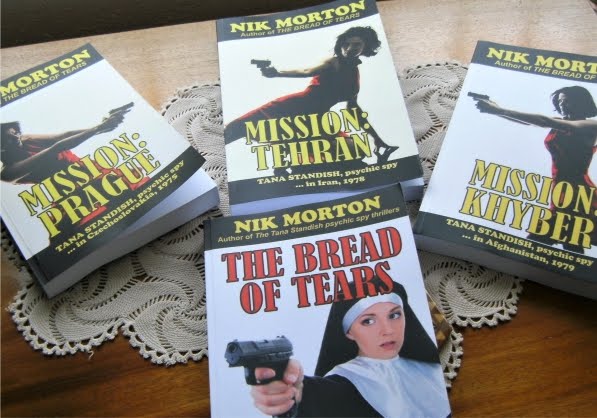Lee Child’s twentieth Jack
Reacher novel Make Me (2015) offers
more of what his millions of readers have come to expect.
It begins with the
clandestine burial of a guy called Keever, which is momentarily disturbed by
the passing of a delayed night train, which is significant…
Reacher has dropped off at a
one-horse town called Mother’s Rest. He’s merely curious how the place got its
name, so stopped for an overnight stay to find out; he doesn’t get to know
until p491; in the meantime, he meets retired FBI special agent Michelle Chang
and learns she’s now running a private investigation business and is the backup
called in by her associated Keever...
The pair hit it off and
Reacher becomes intrigued by the apparent disappearance of Keever.
Their enquiries seem to upset
some locals who object to their presence. Reacher’s first set-piece of violence
(p92) deters two of them effectively. Chang and Reacher’s investigation takes
them beyond the town (to Oklahoma City, Los Angeles and Chicago) and delves
into the unpleasant depths of the internet, where lurks the dark side of human
nature.
The pace begins in a leisurely
fashion and gradually picks up until the set-piece denouement.
Child has a legion of fans
because he writes page-turning stories that pull you in, and this book is no
exception. It’s a fast read.
Many fellow writers are not
fans of his books – for a number of reasons, not least perhaps because he isn’t
‘literary’ and uses simple vocabulary. [Reacher went and took a shower’ (p68)]. He’s
not averse to repeating words in the same paragraph or page. He describes at
great length places and buildings that have very little relevance to the
storyline or scenes in the plot.
His book titles are often
quite odd, too: Make Me is a good
example. The only place I found those words was on p54: ‘Plus he calibrated it
to make me younger than I am.’ The words may have popped up elsewhere. The
meaning can be either ‘force me, if you can’ or ‘you have identified me’ –
perhaps!
He’s good at dialogue. There
can be pages of it, and not that many cues to signify who is speaking because
it’s obvious in the context of what is being said. When he does employ a speech attribution it
is mostly ‘he said’ – Reacher paused a beat and said, ‘Who exactly are you?’ Or:
Reacher said, ‘That’s you?’
Occasionally, he varies this: ‘Interesting,’ Reacher said. He doesn’t bother
with alternatives to ‘said’ and it works just fine for him and, clearly, his
readers.
He injects humour. ‘It’s
going to be like picking a lock with spaghetti.’ (p162)
He doesn’t use f-words,
settling for ‘bullshit’ most of the time. By doing this he probably alienates
some readers who prefer more ‘realism’; yet this is fiction and escapism, so
these thrillers don’t have to employ gutter language to strengthen the story. Indeed,
he probably gains readership because he doesn’t have his characters ‘effing’ at
all and sundry.
He’s good at confrontation
and fight scenes. Tension is raised and details are dispensed for what might
take only a few seconds but in slow-time seem longer as the words pour out. It
is remarkable what can pass in the mind in a fraction of a second at heightened
awareness, and he manages to convey this very efficiently on several occasions.
Adam Hall’s secret agent Quiller
would treat combat in a similar analytical vein.
He’s a master at cranking up
the tension in a scene:
‘I’m getting impatient here.’
Wet lips.
Moving eyes.
Urgent.
No response.
Then Reacher… (pp334/335)
Very filmic.
So, whatever Child’s
perceived faults, his phenomenal success suggests that he has captured that
elusive readability trait other writers hanker after.
Editorial comment
More than once Child writes: ‘Reacher
said nothing.’ (for example, pp291, 353 and 407). Sometimes other characters
get the same line. Interestingly, there’s a book entitled Reacher Said Nothing by Andy Martin, which looks over Child’s
shoulder while he writes Make Me. (It’s
now only available second-hand on Amazon, and at silly prices too!)
An observation is made when a
magazine is found with a bookmark at the front of an article. Reacher’s
assumption is that the magazine owner hasn’t read the article yet. (p108). This
doesn’t necessarily hold up: the marker could be there for future reference,
the piece having already been read.
A number of significant if
minor characters don’t have names. They’re ‘the one-eyed guy’, ‘the Moynahan
who had gotten kicked in the balls’, ‘the spare parts guy from the irrigation
store’, ‘the counterman’, ‘the hog farmer’, ‘the guy from Palo Alto’ and ‘the
man with the ironed jeans and the blow-dried hair’ – the latter is sometimes
shortened to ‘the man with the jeans and the hair’. The repetition of these ‘names’
becomes tedious, though they’re probably easier for the reader to identify
rather than a single name. I appreciate the predicament; multiple characters
with names can become confusing. Sometimes you can identify a bit-player by
their description, which I’ve done before: One-eye, Spare-parts, Blow-dry,
maybe. One of the most overused words in the novel is ‘guy’; it grates.
‘Mrs Eleanor Hopkins, widow,
previously a wife and a laboratory researcher…’ (p271) Well, yes, she would be
a wife previously if she’s now a widow…




























